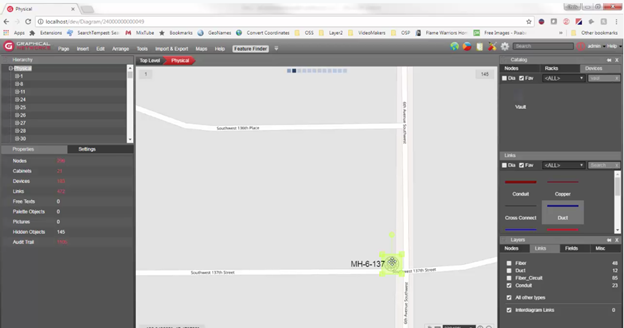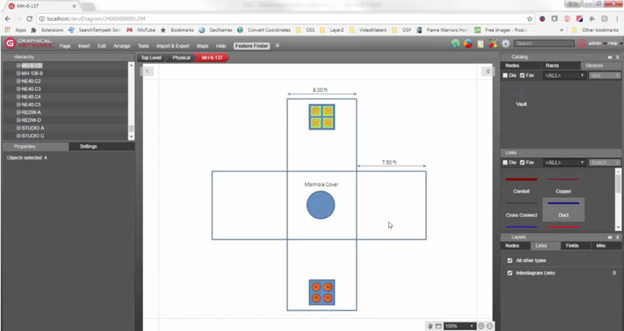
Need location maps of your fiber plant’s handholes, manholes, conduits, and more? With netTerrain OSP software, it’s easy: you can add, view, and search for any elements in your OSP network in seconds (no more sorting through various spreadsheets and Google Earth customizations!).You can document all of your connections, your manholes, handholes, fiber enclosures, splitters, and even show the fiber cable terminating inside a room or a port inside a LIU/patch panel.
Using software like netTerrain’s GIS-enabled street views (which is powered by OpenStreetMaps), you can place your manholes, handholes, and outdoor fiber enclosures on streets (and draw your conduits to follow the streets), or if you know the lat/long coordinates, you can place objects in their exact position. In addition to adding in manholes, handholes, and conduits, you can really place anything you’d like on your maps: poles, towers, antennas, and more. The three most common object types, in netTerrain however, are: manholes, conduits, and ducts.
Adding handholes, manholes, and conduits in netTerrain is simple: just place a manhole, for instance, on one part of the map: you can easily join them with a conduit and place the fiber cables inside the conduits. Easily move the connections to follow a street. Already have your manholes in a spreadsheet? netTerrain has a button for that (spreadsheet import). Have them in a database? We have an integration toolkit that makes it easy. Have them in Google Earth diagrams? You can import and export KMZ/KML diagrams in netTerrain, too.
If you don’t already have your manholes documented in some kind of external system, you can create them manually. Just go to the catalog and search for a manhole object (netTerrain comes with thousands of predefined objects, you can model your own objects in seconds, or we’ll do it for you).
 Example in netTerrain: Adding a Manhole is Easy
Example in netTerrain: Adding a Manhole is Easy
You can give your manhole any name you’d like and assign it with any number of properties/fields that may be relevant for you. Once you’ve placed your manhole, whether automatically or manually, you can drill down into your manhole.
You’ll see that it already has a butterfly diagram in it:
 Example in netTerrain: Document Any Elements You’d Like in Manhole Diagrams
Example in netTerrain: Document Any Elements You’d Like in Manhole Diagrams
Manholes can have duct banks, or splice boxes inside. You can really add any OSP elements that you’d like documented inside of the manhole. Wanna learn more? Read more in-depth on this topic (and check out a video) by clicking here.
In a nutshell, that’s a crash course in using netTerrain for placing and tracking the location of your manholes and handholes in your outside plant network. If you’d like to test-drive netTerrain for free, or just have some questions, we’re here to help! Just click here to get started.